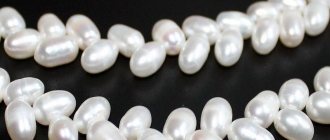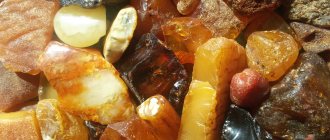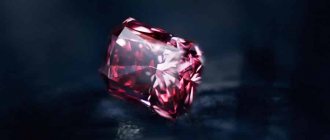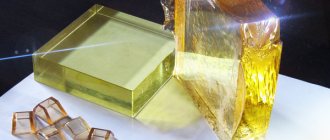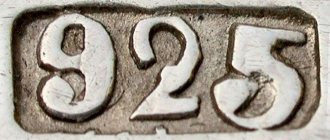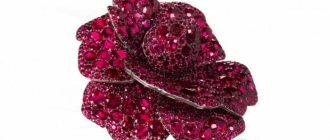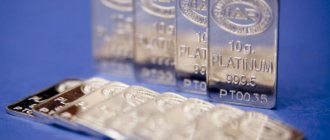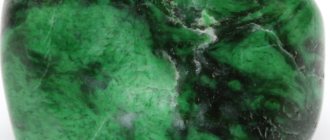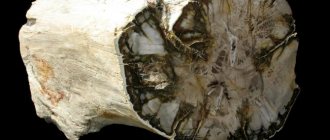Sapphire is a first tier gemstone. In terms of strength and beauty, it is inferior to few of its brothers. It is not surprising that such expensive beauty is sought to be counterfeited. A specialist can distinguish natural from artificial sapphire. But following simple rules will help you insure yourself against counterfeiting. Everyone will feel like a jeweler when experimenting with stones.
What does a gem look like?
The most popular crystals are in the classic blue range, from rich blue to violet.
- Natural stones are colorless, yellow, green, brown-orange. There are no red sapphires in this variety, these are rubies.
- The highest quality is moderate blue, the ideal color is cornflower blue.
- The velvety cornflower blue hue helps to distinguish real Kashmir stone.
- Burmese and Sri Lankan gems are famous for their “silk”. These are needle fibers intersecting at an angle of 60°. Visible under a magnifying glass.
The crystal is dichroic, that is, it splits the sun's rays. This creates a play of light and a bright glass shine.
Which sapphire is better to choose: natural or synthetic
Natural stones are several times more expensive than their synthetic counterparts. This is explained by the cost of products, which includes production and sales costs. Deposits of natural minerals are drying up every year. In addition, large resources are spent on mining gems, which also increases the final cost of jewelry.
Natural stones are very expensive.
The production of synthetic corundum is cheaper. But this does not mean that the stone obtained artificially is worse. It often looks more aesthetically pleasing than the original and has brighter colors. In structure and composition it is identical to natural minerals.
“Analogs” of sapphire offered on the market
There are several imitations of the precious stone:
- outright fakes;
- doublets;
- artificially grown specimens;
- less expensive natural gems.
There are general identification methods and separate ones for each group.
Fakes
Ordinary bottle glass is passed off as a precious stone. It is not difficult to recognize it - the bubbles inside, unlike synthetic or natural minerals, heat up immediately in your hands.
Doublets
There are a lot of composite stones on the jewelry market, made up of several layers - doublets, triplets. The top of the product is a real sapphire, the bottom is glass, an artificial crystal or a cheap gem. The gluing is detected by examining the product under a magnifying glass.
They actively counterfeit jewelry in frames that hide the problematic part of the crystal.
Artificial stones
The official way to obtain gems. A popular method is the Verneuil technology. Source materials – natural corundum chips, chromium, titanium, iron. Vanadium, nickel, magnesium or cobalt oxide is added for pigmentation. Crystals are obtained by firing under pressure. Used in medicine, engineering, technology. Sapphire crystal is found in airplanes, rockets, and branded watches.
The grown artificial sapphire copies the characteristics of the original, in some cases it surpasses it, so it is difficult to recognize. The main marker is the much lower price.
Other natural gems
Natural cheap stones are passed off as sapphire:
- kyanite;
- tanzanite;
- tourmaline;
- spinel.
To recognize a stone, a refractometer is used - a device that determines the degree of refraction of light. The result is checked to the second decimal place. It has a refractive index of 1.76–1.77, while spinel has a refractive index of 1.72. A deviation of 0.01 indicates a different stone.
In addition, tanzanite is identified by its reddish background. Blue spinel specimens, distinguished by their dark shade, are passed off only as low-grade sapphire. Kyanite has a banded color structure. Only a jeweler can distinguish sapphire from tourmaline using a special composition.
History of invention
For the first time, the French scientist Auguste Victor Louis Verneuil thought about the possibility of creating artificial precious stones. His journey of invention began in 1886 and lasted 16 long years. Only after this time did he announce the discovery and give comprehensive information about the results of the long experiment. He said that using high temperatures and the drop precipitation method, it is possible to obtain synthesized minerals, in particular blue corundum. Subsequently, this method became known as the Verneuil method. Afterwards, other scientists improved this method and created their own based on it. But for the first time, the discovered method is still successfully used in the chemical industry.
Mechanical impact
A natural gem has sharp corners and smooth edges. In terms of hardness and strength, it is inferior to the strongest crystal – diamond. Only the same sapphire or diamond can damage it. But it easily scratches a hard surface, like glass.
You can check a sapphire by drawing a groove. Nothing will happen to the natural one; a mark will remain on the fake.
But this is not an absolute indicator. Tourmaline also scratches glass.
It is better to recognize a gem in this way in an inconspicuous area.
Foreign matter analysis
Natural conditions and the thousands of years during which crystals form differ from those in the laboratory. Therefore, you can determine the authenticity of a crystal visually:
- A high-quality stone must have inclusions and a heterogeneous structure. Visible under a magnifying glass or in bright daylight.
- The inclusions, visible to the naked eye, are characteristic of natural low-grade specimens.
- This one does not contain gas bubbles like glass. But this is not a 100% method, because the authors of the fakes have studied similar things.
- To determine the origin, the sample is placed in a jar of monobromonaphthalene. The container is placed on white paper and a light source is placed on the side. With this lighting, inclusion-strips are visible. In natural stone they are straight, in fake ones they are curved.
Specimens with the asterism effect, that is, inclusion in the form of a six-rayed “star,” are valued. It is easy to distinguish such a sapphire from a fake. With a smooth rotation of a natural gem, the star moves, but the imitation one remains in the center. They cannot fake the effect yet.
Color
A good way to check authenticity. The color of a natural crystal does not change under different lighting conditions. Therefore, the sample is evaluated outside during the day, then under the light of a light bulb. A difference of several tones indicates a fake.
If the certificate indicates that the stone has undergone heat treatment, it is checked under ultraviolet light. Synthetic ones will have a greenish tint, while natural ones have white highlights.
Jewelry with synthetic stone
Artificially grown stones can reduce the cost of jewelry with inserts. In terms of their structure and physicochemical properties, they are complete analogues of natural minerals. Externally they are even superior to the original.
Jewelry with synthetic stones can reduce the cost of the product.
Natural rocks do not always have a smooth surface without cracks and foreign inclusions. Sapphire corundum is free from all these disadvantages: jewelry with such stones looks more attractive from an aesthetic point of view.
What to look for when choosing
When purchasing a product with sapphire corundum, you need to pay attention to the tag, which should indicate information about the artificial origin of the mineral. The stone is best viewed in good light under a magnifying glass. The crystal grown in the laboratory has an even color and is transparent. The only foreign inclusions that can be seen are air bubbles.
How to wear and care
Nanosapphires are durable and resistant to mechanical stress, so they do not require special care. When dirty, clean them with running water or soapy water, and then wipe with a soft cloth. It is better to store items with sapphires in a separate fabric bag, since due to the high strength of the stone they can damage other jewelry.
Corundums should not be thrown or dropped. Despite their hardness, microcracks may appear in them, which subsequently leads to destruction. Chips on the surface spoil the appearance of the products.
Formal methods
Since none of the methods available to the average consumer to verify the authenticity of a sapphire is reliable, specialists are involved in the process. The certificate or passport is studied independently.
Verification of documents
In order not to pay a lot of money for synthetics, purchases are made in salons with an impeccable reputation, where they will provide a certificate for each expensive stone.
The seller is obliged to provide information about additional processing of the stone. It is known that most crystals are refined. The crystal is heated or irradiated with x-rays to make the color richer and the background more uniform. Natural specimens pass the test, artificial specimens become striped.
A reliable sign is the price. A first-line natural gemstone does not come cheap.
Invitation of an expert
To avoid any doubts, a jeweler or gemologist who is not interested in the final result is involved in the purchase. He will make a preliminary conclusion in the store. He will be able to definitively distinguish a fake by using a professional tool. You will have to pay for the service, but this is a small thing compared to the cost of natural stone. And personal peace of mind is more valuable.
Characteristics of artificial sapphire
In nature, precious sapphire is a mineral of the oxide class, a type of corundum of blue and dark blue color. It is a hard, fascinating and rare stone, which leads to its high price. The cost of laboratory analogues is lower, and that is why its imitation is so popular, which only a specialist can distinguish from the real thing. Modern technologies make it possible to bring any saturation to its color.
Synthetic sapphire is not much different from natural sapphire. There is no need to confuse diffusion stone with it, which is fundamentally different from artificial stone - diffusion stone is not grown from scratch, but is only processed in a similar way.
Popularity in the world
The cost of artificial sapphires directly depends on the quality and size, and synthesis allows you to achieve any crystal parameters, and the equipment for its growth is constantly improving and becoming cheaper. In terms of its properties, man-made corundum is as close as possible to the original from the bowels of the planet. The synthesis product, like an ordinary mineral, has no chips, cracks, or other damage. This attracts jewelers and consumers of such products, who prefer to insert these durable stones into their gold earrings.
Various ways to obtain
Today there are three most common methods of growing crystals. It is worth immediately noting that they are used to obtain not only corundum, but also other minerals used in jewelry and industry.
Verneuil method
According to currently accepted standards, the name of this scientist is read as Vernee, but the name of the method has already taken root. The essence of the method is that, under the influence of oxygen, the alumina mixture passes through a flame, melts and is collected on a special pin. After this, the pin is again placed in the flame, and the material that has had time to harden melts again, and several crystals are formed. The one that is oriented towards the fastest growth becomes the seed for a new stone.
Crystals grown in this way are called Buli. This may be due to the fact that the first samples obtained were round in shape.
Czochralski method
It is based on strong heating of the substance from which it is planned to grow a crystal in a fireproof container. After passing the melting point, the seed of the future crystal is placed inside, around which it begins to form. During crystal growth, the seed is gradually lifted upward while simultaneously rotating around its axis. The result is a narrow and rather long crystal.
Melting zone method
Another method that has become quite popular recently is the melting zone method. Parts of the container with the material for the future stone are heated sequentially. Thanks to this, the crystal grows.
People also learned to make the most valuable sapphires, star sapphires. The technology was developed by the division and involves adding rutile to the alumina mixture. The size and location of rutile needles can be controlled by adjusting the flow rate of oxygen passing through the vessel with the melt. The creation of a crystal in this case is carried out by the Verneuil method.
Types of artificial gems
It takes several thousand years to grow a natural gem, while scammers get a fake one in just a couple of weeks. You can also use faster methods. Existing inclusions can be called differently.
Fakes
Often scammers use regular ground glass that looks like sapphires. However, such stones will contain bubbles.
Doublets
In this case, a real sapphire is glued onto an artificial crystal, glass, or cheap gem. The difference can be seen under a magnifying glass.
Artificial stones
In order to be as close as possible to a natural stone, sapphire is grown using the Vernel, Chorhalski, and Zone melting methods. Source materials: titanium, chromium, natural corundum chips, iron, nickel and so on. The resulting samples are used in technology, medicine, rockets, and the jewelry business.
Other natural stones
The following minerals are similar in appearance to sapphire: spinel, kyanite, tourmaline, tanzanite, topaz.
Remarkable appearance
The experienced eye of a real craftsman or jewelry seller with many years of experience knows how a real gem can differ from an artificial one. The main criteria for distinguishing natural from artificial sapphire:
- Natural stone is harder than grown stone.
- Different growth patterns.
- Sapphires from the laboratory have no flaws (cracks, even color, etc.).
Note! Fraudsters may deliberately grow artificial samples with impurities to give a more natural texture. As a result, the stone is mistaken for a real one and bought at an inflated price, especially if the stone is magical.
